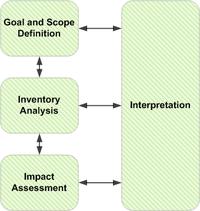
Photo from wikipedia
Background Primary Sjögren’s syndrome (pSS) is characterized by lymphocytic infiltration of the exocrine glands. These patients have a higher risk than the general population of developing non-Hodgkin lymphoma (NHL). This… Click to show full abstract
Background Primary Sjögren’s syndrome (pSS) is characterized by lymphocytic infiltration of the exocrine glands. These patients have a higher risk than the general population of developing non-Hodgkin lymphoma (NHL). This risk also increases with the time of evolution of the disease. pSS is also associated with the development of non-hematological cancer such as thyroid, digestive or gynecological among others. Objectives The aim of the study is to explore the association between the development of neoplasia and demographic, clinical or therapeutic factors in pSS. Methods The SJOGRENSER registry is a multicenter, cross-sectional study of patients with pSS who meet the American-European consensus criteria of 2002, of 33 Spanish rheumatology units. The demographic, clinical, analytical, therapeutic and neoplastic data were collected through review of the clinical records and interviews with the patients. Previously, all the patients signed informed consent and the approval of the local ethic committees was obtained. Descriptive statistics was used for the analysis of the data. The chi-squared test was used to establish the statistical associations and it was considered a p <0.05 as significant. Bivariate logistic regression models were used to identify the effect of each independent variable on the main variable (neoplasia); the multivariate analysis was used to establish the independent effect of the patient characteristics associated with the dependent variable. Results Four hundred and thirty-seven patients were included in SJOGREN-SER Registry (female gender 95.19%; median age 58.3 years). We found 30 patients (6.86%) with neoplasia (3 of them with more than one neoplasia): 7 with lymphomas (23.3%) (4 MALT lymphomas, 2 Hodgkin’s lymphomas, 1 immunocytoma), 9 with gynecological neoplasia (30%), 2 with digestive malignancies, 2 with hematological, 2 with endocrine, 6 with malignancies in other locations, 3 with multiple mieloma and 2 patients with Waldenstrom macroglobulinemia. The results of the bivariate analysis are shown in the table. The factors significantly associated with the development of neoplasia were older age, glandular inflammatory involvement, lung involvement and use of rituximab. The age at diagnosis of the disease tended to be higher in the group with neoplasia (50.1 (± 12.9) vs 54.7 (± 11.7), p = 0.059). In the multivariate analysis, positive associations were found for the development of neoplasia in older patients (OR 1.045; CI95% 1.010-1.081), patients with glandular inflammation (OR 3.104; CI95% 1.396-6.906), and use of rituximab (OR 3.745; CI95% 1.386-10.118). Variable Neoplasia - Neoplasia + p Age (years) 58.3 63.6 0.023 Glandular inflammation (%) 31 53.3 0.012 Lung involvement (%) 8.9 23.3 0.010 Rituximab (%) 6 23.3 <0.001 Conclusion Thirty (6.86%) patients with pSS from the SJOGRENSER registry developed some neoplasia; the most frequent was gynecological, followed by lymphoproliferative processes. Older age, glandular inflammatory involvement and use of rituximab (presumably indication bias) were associated with the presence of neoplasia. References [1] Brito –Zeron, et al. Characterization and risk estimate of cancer in patients with primary Sjögren syndrome. Journal of hematology & oncology 2017;10:90. [2] Liang Y, et al. Primary Sjögren syndrome and malignance risk: a systematic review and meta-analysis. Ann Rheum Dis 2014;73:1151 Disclosure of Interests Monica Fernandez Castro: None declared, Carlos Sánchez-Piedra: None declared, Jose Luis Andreu: None declared, Jose Rosas Consultant for: Abbvie, Amgen, Bristol, Janssen, Lilly, Merck Sharp & Dohme, Pfizer, UCB Pharma, Speakers bureau: Abbvie, Amgen, Bristol, Janssen, Lilly, Merck Sharp & Dohme, Pfizer, UCB Pharma, Victor Martinez Taboada: None declared, Alejandro Olive: None declared
Journal Title: Annals of the Rheumatic Diseases
Year Published: 2019
Link to full text (if available)
Share on Social Media: Sign Up to like & get
recommendations!